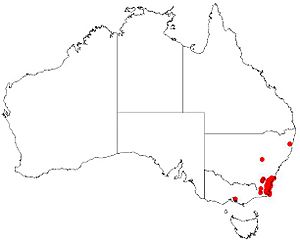Willow needlewood facts for kids
Quick facts for kids Willow needlewood |
|
|---|---|
 |
|
| Scientific classification | |
| Genus: |
Hakea
|
| Species: |
macraeana
|
 |
|
| Occurrence data from AVH | |
Hakea macraeana, also called the willow needlewood or Macrae's hakea, is a type of shrub or small tree. It grows naturally in eastern Australia. A botanist named Ferdinand von Mueller first described this plant in 1886. It was named after George Macrae, who helped collect the plant.
Contents
What is Willow Needlewood?
The willow needlewood can grow as a shrub or a small tree. It can reach heights of 1 to 10 meters (about 3 to 33 feet) tall. This plant has branches that droop downwards.
Leaves and Flowers
The leaves of Hakea macraeana look like needles. They are usually 4 to 15 centimeters (about 1.5 to 6 inches) long. Even though they feel soft, each leaf has a sharp point at its tip.
The flowers appear on the stems from August to October. They are white or cream-white in color. Each group of flowers, called an inflorescence, has two to six small flowers.
Seeds and Pods
After the flowers bloom, oval-shaped woody seed pods grow. These pods are warty and brown. They are about 2.8 to 4 centimeters (1.1 to 1.6 inches) long. They are also 1.8 to 2.4 centimeters (0.7 to 0.9 inches) wide.
Inside each pod are two seeds. These seeds are dark grey or dark brown. They are about 2.2 to 2.7 millimeters (0.08 to 0.1 inches) long. Each seed has a thin "wing" that helps it fly in the wind.
Where Willow Needlewood Grows
Hakea macraeana is found in the south coast and southern tablelands of New South Wales, Australia. It can grow at high places, up to 1060 meters (about 3,478 feet) above sea level.
A group of similar plants in Dorrigo, northern New South Wales, was once thought to be Hakea macraeana. However, scientists later found it was a different species called H. ochroptera.
This plant usually grows under taller trees in sclerophyll forests. It prefers rocky soils. Scientists are still learning how this plant reacts to bushfires.
Growing Willow Needlewood
The willow needlewood is not often grown by people. However, it could be useful as a screening plant. This means it can be planted to create a natural fence or privacy screen.
It is quite easy to grow and can adapt to different types of soil. It does well in both light and heavy soils. Hakea macraeana grows best in areas that get more than 450 millimeters (about 17.7 inches) of rain each year. It can also handle moderate frosts.

